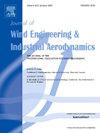基于数字孪生的双箱式桥面锁紧区涡激振动预测
IF 4.9
2区 工程技术
Q1 ENGINEERING, CIVIL
Journal of Wind Engineering and Industrial Aerodynamics
Pub Date : 2025-09-29
DOI:10.1016/j.jweia.2025.106242
引用次数: 0
摘要
风洞试验和计算流体力学(CFD)模拟是研究桥面设计阶段涡激振动(VIV)的两种常用方法。然而,目前的实践和研究表明,这两种方法都有其自身的不确定性和不足。因此,本研究整合了两种方法来开发全球数字双胞胎,用于调查其锁定区域内桥面部分的VIV。首先将双箱桥面作为实体在风洞中进行测试,并收集相关的动声信息。通过CFD仿真,建立了物理实体的虚拟模型。将物理模型的测量数据进行优化融合,将虚拟模型与物理实体进行映射,从而建立给定风速下甲板截面的局部数字孪生体。随后在本地数字孪生和克里格插值的基础上创建全球数字孪生。采用局部和全局数字孪生模型来研究和消除阻塞效应,并预测船闸区域内不同阻尼水平和风速下甲板截面的涡激振动。结果表明,与单独的风洞试验或CFD模拟相比,所开发的数字孪生体可以提供更多的信息和更准确的甲板截面涡激振动预测。本文章由计算机程序翻译,如有差异,请以英文原文为准。
Digital twin-based prediction of vortex-induced vibration of a twin-box bridge deck within the lock-in region
Wind tunnel tests and computational fluid dynamics (CFD) simulations are the two most common methods for investigating vortex-induced vibration (VIV) of a bridge deck at its design stage. However, current practice and research indicate that the two methods have their own uncertainties and drawbacks. This study thus integrates the two methods to develop global digital twins for investigating the VIV of a bridge deck section within its lock-in region. A twin-box bridge deck is first tested in a wind tunnel as a physical entity, and the relevant VIV information is collected. A virtual model for the physical entity is established using CFD simulation. The virtual model is then mapped with the physical entity through fusing the measurement data from the physical model with an optimization process, thereby establishing a local digital twin of the deck section for a given wind speed. Global digital twins are subsequently created based on local digital twins and the Kriging interpolation. The local and global digital twins are employed to investigate and eliminate blockage effects, and to predict the VIV of the deck section at different damping levels and wind speeds within the lock-in region. The results obtained demonstrate that the developed digital twins can provide more information and more accurate prediction of VIV of the deck section, compared with that provided by wind tunnel tests or CFD simulations alone.
求助全文
通过发布文献求助,成功后即可免费获取论文全文。
去求助
来源期刊
CiteScore
8.90
自引率
22.90%
发文量
306
审稿时长
4.4 months
期刊介绍:
The objective of the journal is to provide a means for the publication and interchange of information, on an international basis, on all those aspects of wind engineering that are included in the activities of the International Association for Wind Engineering http://www.iawe.org/. These are: social and economic impact of wind effects; wind characteristics and structure, local wind environments, wind loads and structural response, diffusion, pollutant dispersion and matter transport, wind effects on building heat loss and ventilation, wind effects on transport systems, aerodynamic aspects of wind energy generation, and codification of wind effects.
Papers on these subjects describing full-scale measurements, wind-tunnel simulation studies, computational or theoretical methods are published, as well as papers dealing with the development of techniques and apparatus for wind engineering experiments.

 求助内容:
求助内容: 应助结果提醒方式:
应助结果提醒方式:


